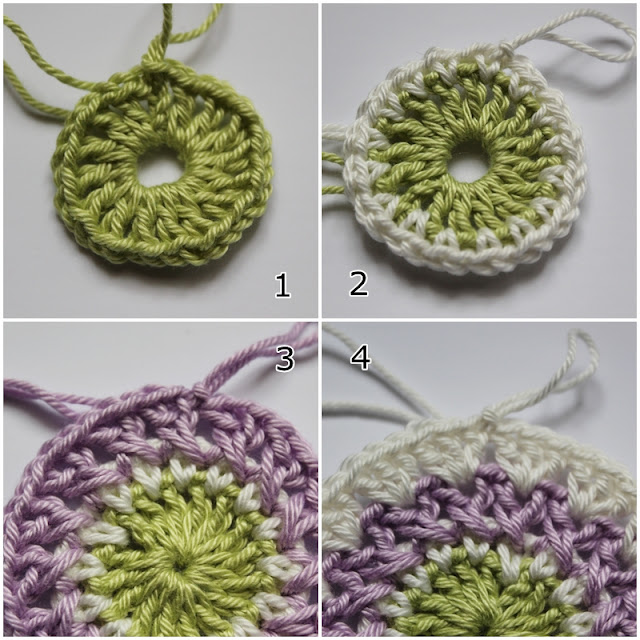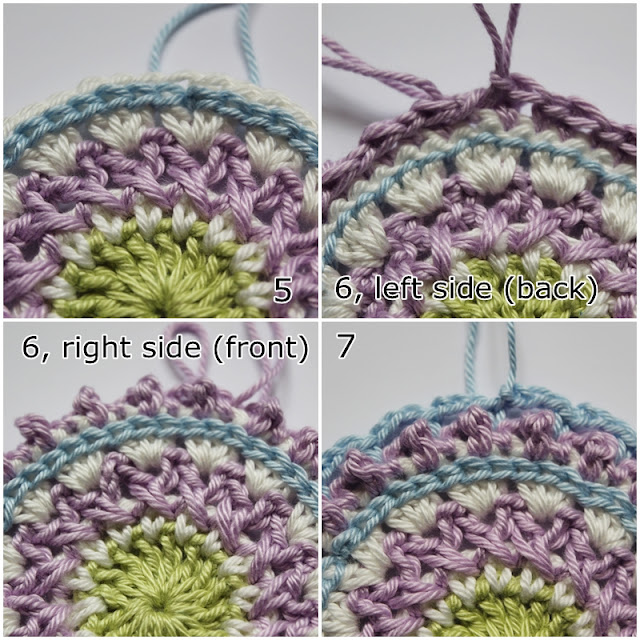Crochet Spring Bubbles Mandala
The Crochet Spring Bubbles Mandala is a charming and intricate design that will add a touch of whimsy to your home decor or wardrobe. This delightful pattern features delicate bubbles and intricate details that make it a joy to create. With its cheerful colors and captivating design, this mandala is not only a fun project to crochet but also a beautiful piece to showcase once finished. Whether you're an experienced crocheter looking for a new challenge or a beginner eager to try something new, the Crochet Spring Bubbles Mandala is sure to bring a smile to your face and brighten up any space it graces. Get ready to immerse yourself in a world of creativity and relaxation as you crochet this enchanting mandala!

Material:
All you need for this Mandala are small amounts of your favorite yarn and the according hook. For this Tutorial I worked with 4 different colors of cotton yarn (Catania by Schachenmayr) and a 2.5mm hook. My Mandala measures 13,5 cm in diameter (5.3") but the size will vary depending on the yarn you use, so gauge is not important.
Pattern Notes and Special Stitches:
For this pattern I use US crochet terms. Starting with a magic ring, we’ll need the following stitches: chain stitch (ch), slip stitch (slst), single crochet (sc), double crochet (dc), treble crochet (tr) and some
Special Stitches:
Crossed Double Crochet (crossed dc): yarn over (yo), and – working over the last dc you’ve just made – insert hook into the stitch before the dc you’ve just made and finish dc as usual. (Together with a dc and ch-1, the crossed dc form a kind of “crossed V-stitch”, you could say).
Surface Stitches: having a loop on your hook and holding the yarn behind your work, insert hook in between the next two dc’s, yo, pull loop through the gap and through the loop on your hook. Basically, it’s just working slip stitches around the body of the dc.
Double Single Crochet (dsc): insert your hook into the indicated stitch or space, yo, pull through space (2 loops on hook), yo, insert hook into the same space again, yo, pull through space (4 loops on hook), yo, pull through all 4 loops on your hook.
Some of the explanations in this pattern might sound a little bit difficult, but I promise you – with a hook in your hand, it’s all easy-peasy :) If you are an absolute beginner or don’t feel comfortable with the special stitches, I also give you some alternative (easier) solutions for the according rounds!
Please note:
I usually start all my rounds with a standing stitch (i.e. the recquired stitch right away) instead of starting with beginning chains. The written pattern however is with beginning chains, so don’t worry if the pictures don’t match your work exactly! It’s up to you, if you want to start a round with standing stitches or beginning chains.
Rnd 1
Start with a magic ring, ch-4 (counts as dc and ch-1), work (dc, ch-1) 15x into the ring, join with a slst to third ch of your beginning ch’s, fasten off. (16 dc, 16 ch-1 gaps)
Don’t pull the magic ring too tight yet!
Rnd 2
Attach another color with a slst to any ch-1 space, ch-1, sc in same space, ch-1, *sc in the next gap, ch-1*, repeat from * around and join with a slst to first sc, fasten off. (16 sc, 16 ch-1 gaps)
Rnd 3
Attach another color with a sl st to any ch-1 space, ch-4 (counts as dc and ch-1), crossed dc into the ch-1 gap before the gap where you’ve started, *dc into the next free gap, ch-1, crossed dc into the (already “taken”) gap before the stitch you’ve just made* repeat from * around and join with a slst to third ch of your beginning ch’s, fasten off. (16 crossed V-Stitches, 16 ch-1 gaps)
For the crossed dc see “Special Stitches” in the pattern notes above.
For the last dc/crossed dc repetition, place the dc into the space where you’ve already placed your first crossed dc at the beginning of the round – so actually this is not a “free” gap.
You should now have two dc’s (one regular, one crossed) coming out of each ch-1 gap of round 2, right?
You can now pull the magic ring tight, if you haven’t already.
Easy Alternative: just work regular V-Stitches (i.e. dc, ch-1, dc) in every ch-1 gap around.
Rnd 4
Attach another color with a slst to any ch-1 space, ch-3 (counts as dc) and 2 more dc into the same space, *3 dc into the next space*, repeat from * around and join with a slst to beginning ch-3, fasten off. (48 dc, no spaces)

Rnd 5
Holding the yarn at the back of your work, insert hook in between any two dc’s of the previous round, yo, pull loop through the gap and work surface stitches around. To finish the round, work the last surface stitch in the gap where you started, cut thread, and finish off. Use your hook or a needle to pull the loose end through to the back again, tie the two ends together and weave them in.
For the surface stitches see “Special Stitches” in the pattern notes above.
Easy Alternative: just skip this round, it’s just for decoration and won’t change the stitch count.
Rnd 6
Turn your work, so that the left side is facing you! Attach another color with a slst to any dc of rnd 4. Ch-1, sc in the same stitch, tr in the next stitch, *sc in the next stitch, tr in the next stitch* repeat from * around and join with a slst to first sc, fasten off and turn again. (24 sc/tr pairs)
Now you should see the “bubbles” (or bobbles, but I like bubbles better *gg*), that have formed by working the sc/tr combinations.
Make sure you don’t accidently grab the surfaces stitches of round 5 while working this round! (I mention that, because it happened to me before)
Rnd 7
With the right side facing you again, attach another color with a slst to any sc of the previous round (those are the smaller looking, tighter stitches of the two). Ch-1, sc in the same stitch, ch-3, skip the tr, *sc in the next sc, ch-3, skip the tr*, repeat from * around and join with a slst to first sc, fasten off. (24 sc, 24 ch-3 gaps)

Rnd 8
Attach another color with a slst to any ch-3 space, ch-3 (counts as dc) and 2 more dc into the same space, *3 dc into the next space*, repeat from * around and join with a slst to beginning ch-3, fasten off. (72 dc, no spaces)
Rnd 9
Attach another color with a slst to any dc, ch-4 (counts as dc and ch-1), crossed dc into the dc before the stitch where you’ve started, *skip the next free dc, dc into the next dc, ch-1, crossed dc into the skipped dc before the stitch you’ve just made* repeat from * around and join with a slst to third ch of your beginning ch’s, fasten off. (36 crossed V-Stitches, 36 ch-1 gaps)
For the crossed dc see “Special Stitches” in the pattern notes above. Notice the difference to round 3? This time you’ve only got one dc (regular or crossed) coming out of each stitch of the previous round. The crossed V-Stitches don’t “touch” at the base like in round 3.
Easy Alternative: just work regular V-Stitches (i.e. dc, ch-1, dc) in every second dc around, i.e. skip one dc between the V-Stitches.
Rnd 10
Attach another color with a slst to any ch-1 gap of the previous round, ch-1, 2 double sc (dsc) in the same gap, ch-1, *2 dsc in the next gap, ch-1*, repeat from * around and join with a slst to first dsc, fasten off and weave in all the ends. (36x2 dsc, 36 ch-1 spaces)
For the double sc see “Special Stitches” in the pattern notes above.
Easy Alternative: instead of double sc’s use regular sc’s and work (2sc, ch-1) in every ch-1 gap around. But I really hope you try this fun and easy stitch, though – it makes for a nice, dense finish!
